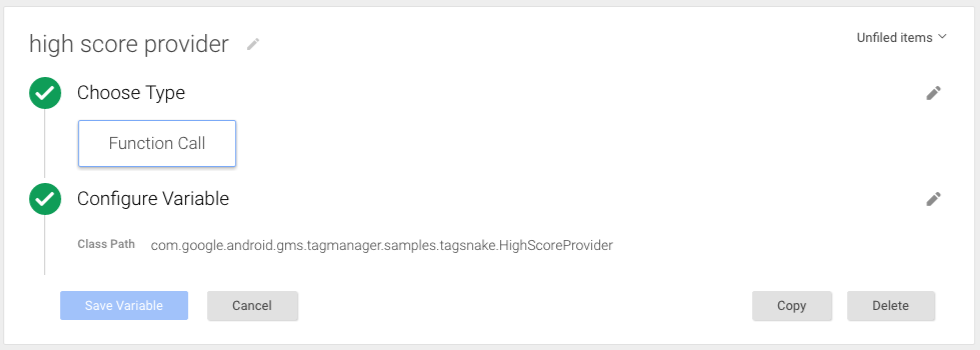Sie können die Funktionalität von Google Tag Manager erweitern, indem Sie Funktionsaufruf-Variablen und Funktionsaufruf-Tags hinzufügen. Mithilfe von Funktionsaufruf-Variablen können Sie die Werte erfassen, die von Aufrufen an vorregistrierte Funktionen zurückgegeben werden. Mit Funktionsaufruf-Tags können Sie vorregistrierte Funktionen ausführen, z.B. um Treffer für zusätzliche Mess- und Remarketing-Tools auszulösen, die derzeit nicht mit Tag-Vorlagen in Tag Manager unterstützt werden.
Benutzerdefinierte Tags und Variablen hinzufügen
So fügen Sie ein benutzerdefiniertes Tag oder eine benutzerdefinierte Variable mit einem Funktionsaufruf hinzu:
Implementieren Sie eine Klasse, die
com.google.android.gms.tagmanager.CustomTagProviderodercom.google.android.gms.tagmanager.CustomVariableProvidererweitert:import android.support.annotation.Keep; import java.util.Map; @Keep public class HighScoreProvider implements com.google.android.gms.tagmanager.CustomVariableProvider { @Override public String getValue(Map<String, Object> map) { synchronized (HighScoreProvider.class) { return ((Long)sHighScore).toString(); } } private static long sHighScore = 0; public static void recordScore(long score) { synchronized (HighScoreProvider.class) { sHighScore = Math.max(score, sHighScore); } } }Wenn Sie ProGuard verwenden, dürfen die Klassennamen und Methoden nicht verschleiert sein. Verwenden Sie dazu die Anmerkung „Behalten“.
Verwenden Sie in der Weboberfläche von Google Tag Manager den voll qualifizierten Klassennamen, um Tags und Variablen einzurichten:

